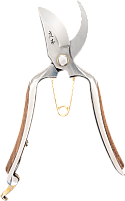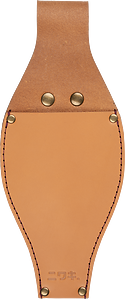Most of our sharp tools are made from carbon steel - this means they may, through regular use, stain (and eventually rust) and gradually lose their edge. Caring for them involves three things…
1. Correct Use:
- Japanese steel is hard and sharp, and can be more brittle than some people are used to - it will chip if abused
- Do not cut wire, metal, stone, plastic or any other hard material (even bamboo fibres and some very hard woods, especially knots and burrs, can damage steel edges)
- Do not twist or apply uneven pressure
- Cut diagonally across branches (not straight across) so you cut along the fibres
- Pay attention to our maximum cut dimensions, and don’t overdo it (shears are not loppers)
- Use the base of the blades, not the tips, for heavier cuts
2. Keeping Them Clean:
- Remove leaf resin, rust and gunk with a Clean Mate and water
- Dry, wipe over with Camellia oil and store in a dry place
3. Keeping Them Sharp:
New tools won’t need sharpening for some time, but after a while you’ll notice them gradually lose their edge, especially if you’re box clipping (you need REALLY sharp blades to get a good finish with box). Use the Niwaki Sharpening Stones for best results (#1000 grit is best for general sharpening).
- Sharpen Secateurs every couple of weeks
- Sharpen Shears and Topiary Clippers EVERY TIME you use them - the difference is amazing
Our Niwaki Stones work for just about every edged blade:
- #220: coarse, for rough blades
- #1000: fine, for regular sharpening - the most useful stone for every day sharpening
- #3000: super fine, for honing and detailed work
For Secateurs:
NB. We strongly advise NOT taking your secateurs apart - they never go back together quite the same.
- Soak stones in water for a few minutes before use, and keep wet during use
- Use the concave edge of the stone, moving from the pivot towards the tip of the blade, following the curve as you go
- FOR STRAIGHT BLADED SHEARS use the flat side of the stone
- Then back again - back and forth along the whole length of the blade
- Use as much of the stone as possible, not just the top inch
- This is a gentle action - don’t use too much pressure
- Next, turn the secateurs over, and use the flat side of the stone to smooth the burr off the inside of the blade, going slightly over, creating a very fine bevel
- Use the convex edge of the stone to clean off the curved edge of the bypass
- Finally, clean and dry the secateurs, and wipe with Camellia Oil




